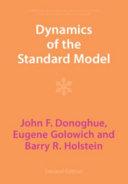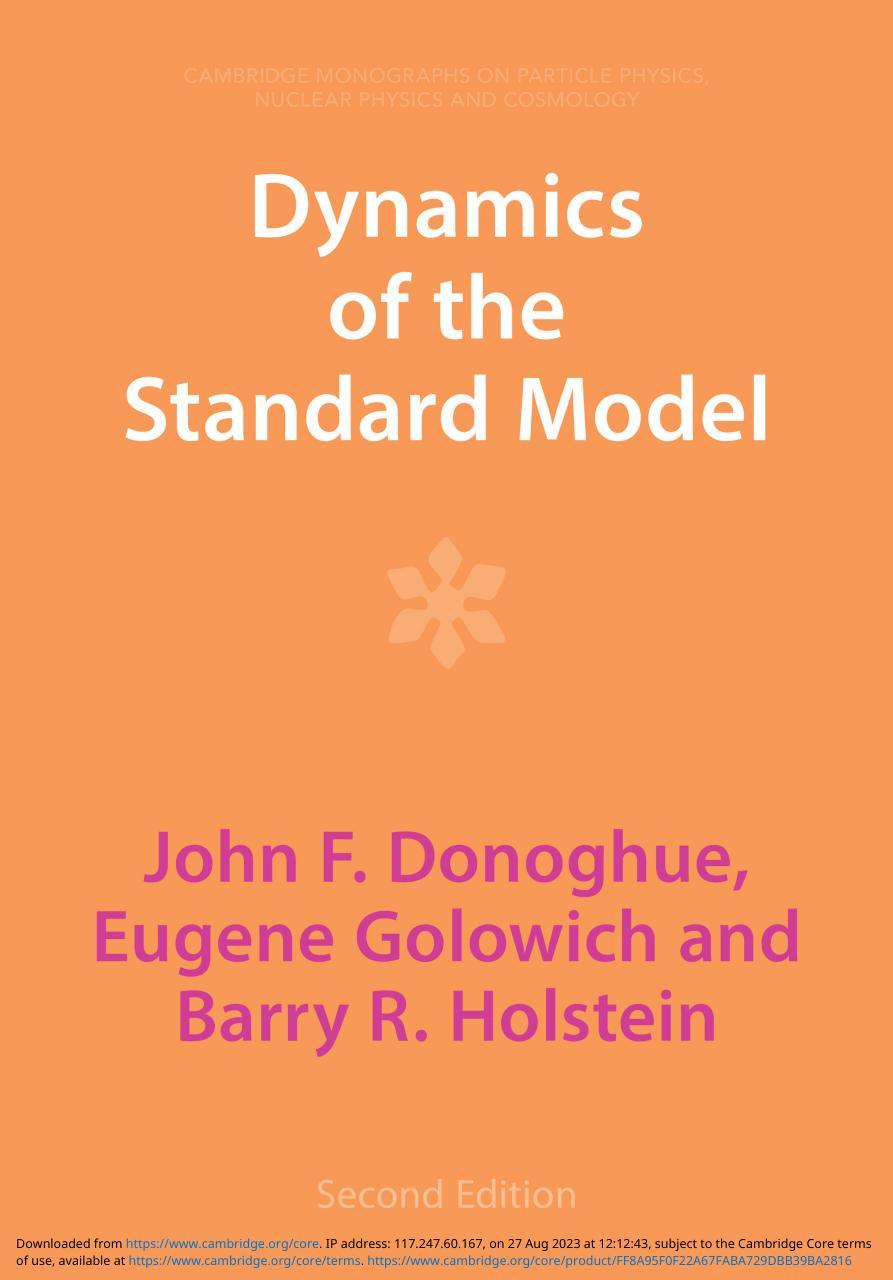DYNAMICSOFTHESTANDARDMODEL
Describingthefundamentaltheoryofparticlephysicsanditsapplications,this bookprovidesadetailedaccountoftheStandardModel,focusingontechniques thatcanproduceinformationaboutrealobservedphenomena.
ThebookbeginswithapedagogicaccountoftheStandardModel,introducing essentialtechniquessuchaseffectivefieldtheoryandpath-integralmethods.Itthen focusesontheuseoftheStandardModelinthecalculationofphysicalproperties ofparticles.Rigorousmethodsareemphasized,butotherusefulmodelsarealso described.
Thissecondeditionhasbeenupdatedtoincluderecenttheoreticalandexperimentaladvances,suchasthediscoveryoftheHiggsboson.Anewchapteris devotedtothetheoreticalandexperimentalunderstandingofneutrinos,andmajor advancesin CP violationandelectroweakphysicshavebeengivenamoderntreatment.Thisbookisvaluabletograduatestudentsandresearchersinparticlephysics, nuclearphysicsandrelatedfields.
This title, first published in 2014, has been reissued as an Open Access publication on Cambridge Core.
JohnF.Donoghue isDistinguishedProfessorintheDepartmentofPhysics, UniversityofMassachusetts.Hisresearchspansparticlephysics,quantumfield theoryandgeneralrelativity.HeisaFellowoftheAmericanPhysicalSociety.
EugeneGolowich isEmeritusProfessorintheDepartmentofPhysics, UniversityofMassachusetts.Hisresearchhasfocusedonparticletheoryandphenomenology.HeisaFellowoftheAmericanPhysicalSocietyandisarecipientof theCollegeOutstandingTeacherawardfromtheUniversityofMassachusetts.
BarryR.Holstein isEmeritusProfessorintheDepartmentofPhysics, UniversityofMassachusetts.Hisresearchisintheoverlapareaofparticleand nucleartheory.AFellowoftheAmericanPhysicalSociety,heisalsotheeditor of AnnualReviewsofNuclearandParticleScience andisalongtimeconsulting editorofthe AmericanJournalofPhysics.
CAMBRIDGEMONOGRAPHSONPARTICLEPHYSICS,NUCLEAR PHYSICSANDCOSMOLOGY
GeneralEditors:T.Ericson,P.V.Landshoff
Availabletitlesinthisseries:
3.E.LeaderandE.Predazzi: AnIntroductiontoGaugeTheoriesandModernParticlePhysics, Volume1:ElectroweakInteractions,the‘NewParticles’andthePartonModel
4.E.LeaderandE.Predazzi: AnIntroductiontoGaugeTheoriesandModernParticlePhysics, Volume2:CP-Violation,QCDandHardProcesses
6.H.GrosseandA.Martin: ParticlePhysicsandtheSchrödingerEquation
7.B.Andersson: TheLundModel
8.R.K.Ellis,W.J.StirlingandB.R.Webber: QCDandColliderPhysics
10.A.V.ManoharandM.B.Wise: HeavyQuarkPhysics
11.R.Frühwirth,M.Regler,R.K.Bock,H.GroteandD.Notz: DataAnalysisTechniquesfor High-EnergyPhysics,Secondedition
12.D.Green: ThePhysicsofParticleDetectors
13.V.N.GribovandJ.Nyiri: QuantumElectrodynamics
14.K.Winter(ed.): NeutrinoPhysics,Secondedition
15.E.Leader: SpininParticlePhysics
16.J.D.Walecka: ElectronScatteringforNuclearandNucleonStructure
17.S.Narison: QCDasaTheoryofHadrons
18.J.F.LetessierandJ.Rafelski: HadronsandQuark-GluonPlasma
19.ADonnachie,H.G.Dosch,P.V.LandshoffandO.Nachtmann: PomeronPhysicsandQCD
20.A.Hofmann: ThePhysicsofSynchrotronRadiation
21.J.B.KogutandM.A.Stephanov: ThePhasesofQuantumChromodynamics
22.D.Green: High PT PhysicsatHadronColliders
23.K.Yagi,T.HatsudaandY.Miake: Quark-GluonPlasma
24.D.M.BrinkandR.A.Broglia: NuclearSuperfluidity
25.F.E.Close,A.DonnachieandG.Shaw: ElectromagneticInteractionsandHadronicStructure
26.C.GrupenandB.A.Schwartz: ParticleDetectors,Secondedition
27.V.Gribov: StrongInteractionsofHadronsatHighEnergies
28.I.I.BigiandA.I.Sanda: CPViolation,Secondedition
29.P.JaranowskiandA.Królak: AnalysisofGravitational-WaveData
30.B.L.Ioffe,V.S.FadinandL.N.Lipatov: QuantumChromodynamics:Perturbativeand NonperturbativeAspects
31.J.M.Cornwall,J.PapavassiliouandD.Binosi: ThePinchTechniqueanditsApplicationsto Non-AbelianGaugeTheories
32.J.Collins: FoundationsofPerturbativeQCD
33.Y.V.KovchegovandE.Levin: QuantumChromodynamicsatHighEnergy
34.J.RakandM.J.Tannenbaum: High-pT PhysicsintheHeavyIonEra
35.J.F.Donoghue,E.GolowichandB.R.Holstein: DynamicsoftheStandardModel, Secondedition
DYNAMICSOFTHESTANDARD MODEL
secondedition
JOHNF.DONOGHUE
UniversityofMassachusetts
EUGENEGOLOWICH
UniversityofMassachusetts
BARRYR.HOLSTEIN
UniversityofMassachusetts
Shaftesbury Road, Cambridge CB2 8EA, United Kingdom One Liberty Plaza, 20th Floor, New York, NY 10006, USA
477 Williamstown Road, Port Melbourne, VIC 3207, Australia
314–321, 3rd Floor, Plot 3, Splendor Forum, Jasola District Centre, New Delhi – 110025, India 103 Penang Road, #05–06/07, Visioncrest Commercial, Singapore 238467
Cambridge University Press is part of Cambridge University Press & Assessment, a department of the University of Cambridge.
We share the University’s mission to contribute to society through the pursuit of education, learning and research at the highest international levels of excellence.
www.cambridge.org
Information on this title: www.cambridge.org/9781009291002
DOI: 10.1017/9781009291033
© John F. Donoghue, Eugene Golowich and Barry R. Holstein 2022
This work is in copyright. It is subject to statutory exceptions and to the provisions of relevant licensing agreements; with the exception of the Creative Commons version the link for which is provided below, no reproduction of any part of this work may take place without the written permission of Cambridge University Press.
An online version of this work is published at doi.org/10.1017/9781009291033 under a Creative Commons Open Access license CC-BY-NC-ND 4.0 which permits re-use, distribution and reproduction in any medium for non-commercial purposes providing appropriate credit to the original work is given. You may not distribute derivative works without permission. To view a copy of this license, visit https://creativecommons.org/licenses/by-nc-nd/4.0
All versions of this work may contain content reproduced under license from third parties. Permission to reproduce this third-party content must be obtained from these third-parties directly.
When citing this work, please include a reference to the DOI 10.1017/9781009291033
First published 2014 Reissued as OA 2022
A catalogue record for this publication is available from the British Library.
ISBN 978-1-009-29100-2 Hardback
ISBN 978-1-009-29101-9 Paperback
Cambridge University Press & Assessment has no responsibility for the persistence or accuracy of URLs for external or third-party internet websites referred to in this publication and does not guarantee that any content on such websites is, or will remain, accurate or appropriate.
ToLincolnWolfenstein
I–4Symmetriesandnearsymmetries11
On-shellrenormalizationoftheelectriccharge35
Electricchargeasarunningcouplingconstant37
II–2QuantumChromodynamics40
SU (3)gaugesymmetry40
QCD tooneloop45
Asymptoticfreedomandrenormalizationgroup51
II–3Electroweakinteractions57
Weakisospinandweakhyperchargeassignments57
SU (2)L × U(1)Y gauge-invariantlagrangian60
Spontaneoussymmetrybreaking62
Electroweakcurrents63
II–4Fermionmixing66
Diagonalizationofmassmatrices66
Quarkmixing68
Neutrinomixing70
Quark CP violationandrephasinginvariants72
IIISymmetriesandanomalies 76
III–1SymmetriesoftheStandardModel76
III–2Pathintegralsandsymmetries79
Thegeneratingfunctional80
Noether’stheoremandpathintegrals81
III–3The U (1)axialanomaly82
Diagrammaticanalysis84
Path-integralanalysis88
III–4Classicalscaleinvarianceandthetraceanomaly95
III–5Chiralanomaliesandvacuumstructure98
The θ vacuum99
The θ term101
Connectionwithchiralrotations102
III–6Baryon-andlepton-numberviolationintheStandardModel103
IVIntroductiontoeffectivefieldtheory 106
IV–1Effectivelagrangiansandthesigmamodel106
Representationsofthesigmamodel107
Representationindependence109
IV–2Integratingoutheavyfields111
Thedecouplingtheorem111
Integratingoutheavyfieldsattreelevel112
Matchingthesigmamodelattreelevel114
IV–3Loopsandrenormalization115
IV–4Generalfeaturesofeffectivefieldtheory119 Effectivelagrangiansandsymmetries120
Powercountingandloops121
Weinberg’spower-countingtheorem122 Thelimitsofaneffectivefieldtheory123
IV–5Symmetrybreaking124
IV–6Matrixelementsofcurrents126
Matrixelementsandtheeffectiveaction127
IV–7Effectivefieldtheoryofregionsofasinglefield129
IV–8Effectivelagrangiansin QED
IV–9EffectivelagrangiansasprobesofNewPhysics138 VChargedleptons
V–3The τ lepton163
Exclusiveleptonicdecays164
Exclusivesemileptonicdecays164 Inclusivesemileptonicdecays167 Someapplicationsof τ decays168
VI–1Neutrinomass173
EquivalenceofheavyMajoranamasstoadimension-five operator175
VI–2Leptonmixing176
VI–3Theoryofneutrinooscillations179 Oscillationsinvacuum179 Oscillationsinmatter:MSWeffect181 CP violation184
VI–4Neutrinophenomenology185
Solarandreactorneutrinos: θ12 and m2 21
Atmosphericandacceleratorneutrinos: θ23 and | m2 32 |
Short-baselinestudies: θ13
VI–5TestingfortheMajorananatureofneutrinos192
VI–6Leptogenesis195
VI–7Numberoflightneutrinospecies197
Studiesatthe Z0 peak197
Astrophysicaldata197
VIIEffectivefieldtheoryforlow-energy QCD
VII–1 QCD atlowenergies200
Vacuumexpectationvaluesandmasses201
Quarkmassratios202
Pionleptonicdecay,radiativecorrections,and Fπ
VII–2Chiralperturbationtheorytooneloop209
Theorder E 4 lagrangian210
Therenormalizationprogram211
VII–3Thenatureofchiralpredictions215
Thepionformfactor215
Rareprocesses219
Pion–pionscattering223
VII–4Thephysicsbehindthe QCD chirallagrangian225
VII–5TheWess–Zumino–Wittenanomalyaction228
VII–6Theaxialanomalyand π 0 → γγ 233
VIIIWeakinteractionsofkaons 237
VIII–1Leptonicandsemileptonicprocesses237
VIII–2Thenonleptonicweakinteraction240
VIII–3Matchingto QCD atshortdistance242
Short-distanceoperatorbasis242
Perturbativeanalysis243
Renormalization-groupanalysis245
VIII–4The I = 1/2rule249
Phenomenology249
Chirallagrangiananalysis252
Vacuumsaturation253
Nonleptoniclatticematrixelements254
VIII–5Rarekaondecays255
IXMassmixingand CP violation 260
IX–1 K 0 –K 0 mixing260 CP-conservingmixing263
IX–2Thephenomenologyofkaon CP violation266
IX–3Kaon CP violationintheStandardModel269
Analysisof | |
Analysisof | |
Chiralanalysisof ( / )EWP
IX–4Thestrong CP problem273
Theparameter θ 273
Connectionswiththeneutronelectricdipolemoment275
XThe N 1 c expansion
X–1Thenatureofthelarge Nc limit278
X–2Spectroscopyinthelarge Nc limit280
X–3Goldstonebosonsandtheaxialanomaly283
X–4The OZI rule285
X–5Chirallagrangians287
XIPhenomenologicalmodels 291
XI–1Quantumnumbersof QQ and Q3 states291
Hadronicflavor–spinstatevectors291 Quarkspatialwavefunctions295 Interpolatingfields297
XI–2Potentialmodel298 Basicingredients298 Mesons300 Baryons301
Colordependenceoftheinterquarkpotential302
XI–3Bagmodel303 Staticcavity304
Spherical-cavityapproximation304
Gluonsinabag307
Thequark–gluoninteraction308 XI–4Skyrmemodel308
Sine–Gordonsoliton309
Chiral SU (2)soliton310 TheSkyrmesoliton312 Quantizationandwavefunctions314
XI–5 QCD sumrules318
Correlators319
Operator-productexpansion321
Masterequation323 Examples324
XIIBaryonproperties 330
XII–1Matrix-elementcomputations330
Flavorandspinmatrixelements330
Overlapsofspatialwavefunctions332
Connectiontomomentumeigenstates333
CalculationsintheSkyrmemodel336
XII–2Electroweakmatrixelements339
Magneticmoments339
Semileptonicmatrixelements341
XII–3Symmetrypropertiesandmasses343
Effectivelagrangiansforbaryons343
Baryonmasssplittingsandquarkmasses344
Goldberger–Treimanrelation347
Thenucleonsigmaterm348
Strangenessinthenucleon349
Quarksandnucleonspinstructure351
XII–4Nuclearweakprocesses355
Measurementof Vud 355
Thepseudoscalaraxialformfactor357
XII–5Hyperonsemileptonicdecay359
XII–6Nonleptonicdecay360 Phenomenology360 Lowest-orderchiralanalysis362
XIIIHadronspectroscopy 366
XIII–1Thecharmoniumandbottomoniumsystems366 Transitionsinquarkonium372
XIII–2Lightmesonsandbaryons376
SU (6)classificationofthelighthadrons376
Reggetrajectories379
SU (6)breakingeffects381
XIII–3Theheavy-quarklimit385
Heavy-flavoredhadronsinthequarkmodel385
Spectroscopyinthe mQ →∞ limit387
XIII–4Nonconventionalhadronstates390
Thefirstresonance– σ (440)391 Gluonia394
Additionalnonconventionalstates396
XIVWeakinteractionsofheavyquarks
XIV–1Heavy-quarkmass399
Runningquarkmass399
Thepolemassofaquark401
XIV–2Inclusivedecays403
Thespectatormodel403
Theheavy-quarkexpansion405 Thetopquark408
XIV–3Exclusivedecaysintheheavy-quarklimit409
Inclusivevs.exclusivemodelsfor b → ceνe 410
HeavyQuarkEffectiveTheoryandexclusivedecays411
XIV–4 B 0 B 0 and D 0 D 0 mixing416 B0 –B0 mixing416
mixing418
XIV–5Theunitaritytriangle420
XIV–6 CP violationin B -mesondecays421
CP-oddsignalsinducedbymixing421
Decaysto CP eigenstates423
Decaystonon-CP eigenstates426
Semileptonicasymmetries427
CP-oddsignalsnotinducedbymixing428
XIV–7Raredecaysof B mesons430
XV–1Introduction434
XV–2MassandcouplingsoftheHiggsboson435 Higgsmassterm436 Thenaturalnessproblem436 Higgscouplingconstants437
XV–3ProductionanddecayoftheHiggsboson442 Decay442 Production445
ComparisonofStandardModelexpectationswithLHCdata447
XV–4Higgscontributionstoelectroweakcorrections448 Thecorrections ρ and r 449
Custodialsymmetry450
XV–5ThequantumHiggspotentialandvacuumstability452
XV–6TwoHiggsdoublets454
XVITheelectroweaksector 458
XVI–1Neutralweakphenomenaatlowenergy458
Neutral-currenteffectivelagrangians459
Deep-inelasticneutrinoscatteringfromisoscalartargets461
Atomicparityviolationincesium462
PolarizedMøllerscattering463
XVI–2Measurementsatthe Z0 massscale464
Decaysof Z 0 intofermion–antifermionpairs466
Asymmetriesatthe Z 0 peak467
Definitionsoftheweakmixingangle469
XVI–3Some W ± properties471
Decaysof W± intofermions471
Triple-gaugecouplings472
XVI–4Thequantumelectroweaklagrangian474
Gaugefixingandghostfieldsintheelectroweaksector475
AsubsetofelectroweakFeynmanrules476
On-shelldeterminationofelectroweakparameters478
XVI–5Self-energiesofthemassivegaugebosons479
Thechargedgaugebosons W± 480
Theneutralgaugebosons Z 0 , γ 482
XVI–6Examplesofelectroweakradiativecorrections483 The
The
The Z→b b vertexcorrection488
PrecisiontestsandNewPhysics489
AppendixAFunctionalintegration 493
A–1Quantum-mechanicalformalism493
Path-integralpropagator493
Externalsources496
Thegeneratingfunctional497
A–2Theharmonicoscillator499
A–3Field-theoreticformalism502
Pathintegralswithfields502
Generatingfunctionalwithfields503
A–4Quadraticforms506
Backgroundfieldmethodtooneloop507
A–5Fermionfieldtheory509
A–6Gaugetheories512
Gaugefixing513
Ghostfields516
AppendixBAdvancedfield-theoreticmethods 520
B–1Theheatkernel520
B–2Chiralrenormalizationandbackgroundfields524
B–3PCACandthesoft-piontheorem529
B–4Matchingfieldswithdifferentsymmetry-transformation properties532
AppendixCUsefulformulae 535
C–1Numerics535
C–2Notationsandidentities535
C–3Decaylifetimesandcrosssections538
C–4Fielddimension541
C–5Mathematicsin d dimensions541
TheStandardModelisthebasisofourunderstandingofthefundamentalinteractions.Atthepresenttime,itremainsinexcellentagreementwithexperiment.It isclearthatanyfurtherprogressinthefieldwillneedtobuildonasolidunderstandingoftheStandardModel.Sincethefirsteditionwaswrittenin1992there havebeenmajordiscoveriesinneutrinophysics,in CP violation,thediscoveries ofthetopquarkandtheHiggsboson,andadramaticincreaseinprecisioninboth electroweakphysicsandin QCD.Wefeelthatthepresentisagoodmomentto updateourbook,astheStandardModelseemslargelycomplete.
Theopportunitytoreviseourbookatthistimehasalsoenabledustosurveythe progresssincethefirsteditionwenttoprint.Besidestheexperimentaldiscoveries thathavetakenplaceduringthesetwodecades,wehavebeenimpressedbythe increaseintheoreticalsophistication.Manyofthetopicswhichwerenovelatthe timeofthefirsteditionhavenowbeenextensivelydeveloped.Perturbativetreatmentshaveprogressedtohigherordersandnewtechniqueshavebeendeveloped. Tocoverallofthesecompletelywouldrequiretheexpansionofmanychapters intobook-lengthtreatments.Indeed,inmanycases,entirenewbooksdedicatedto specializedtopicshavebeenpublished.1 Ourrevisionismeantasacoherentpedagogicintroductiontothesetopics,providingthereaderwiththebasicbackground topursuemoredetailedstudieswhenappropriate.
TherehasalsobeengreatprogressonthepossibleNewPhysicswhichcould emergebeyondtheStandardModel–darkmatteranddarkenergy,grandunification,supersymmetry,extradimensions,etc.Weareatamomentwherethisphysics couldemergeinthenextroundofexperimentsattheLargeHadronCollider(LHC) aswellasinprecisionmeasurementsattheintensityfrontier.Welookforwardwith greatanticipationtothenewdiscoveriesofthenextdecade.
1 Forexample,see[BaP99,Be00,BiS00,EISW03,FuS04,Gr04,IoFL10,La10,Ma04,MaW07,Co11]
Wethankourcolleaguesandstudentsforfeedbackaboutthefirsteditionofthis book.Alistoferrataforthesecondeditionwillbemaintainedatthehomepage ofJohnDonoghueattheUniversityofMassachusetts,Amherst.Weencourage readerswhofindanymistakesinthiseditiontosubmitthemtoProfessorDonoghue atdonoghue@physics.umass.edu.
Fromtheprefacetothefirstedition
TheStandardModellagrangian LSM embodiesourknowledgeofthestrongand electroweakinteractions.Itcontainsasfundamentaldegreesoffreedomthespin one-halfquarksandleptons,thespinonegaugebosons,andthespinzeroHiggs fields.Symmetryplaysthecentralroleindeterminingitsdynamicalstructure.The lagrangianexhibitsinvarianceunder SU(3) gaugetransformationsforthestrong interactionsandunder SU(2) × U(1) gaugetransformationsfortheelectroweak interactions.Despitethepresenceof(alltoo)manyinputparameters,itisamathematicalconstructionofconsiderablepredictivepower.
Therearebooksavailablewhichdescribeindetailtheconstructionof LSM and itsquantization,andwhichdealwithaspectsofsymmetrybreaking.Wefeltthe needforabookdescribingthenextsteps,how LSM isconnectedtotheobservable physicsoftherealworld.Thereareaconsiderablevarietyoftechniques,ofdifferingrigor,whichareusedbyparticlephysiciststoaccomplishthis.Wepresenthere thosewhichhavebecomeindispensabletools.Inaddition,weattempttoconvey theinsightsand‘conventionalwisdom’whichhavebeendevelopedthroughoutthe field.Thisbookcanonlybeanintroductiontotherichescontainedinthesubject, hopefullyprovidingafoundationandamotivationforfurtherexplorationbyits readers.
Inwritingthebook,wehavebecomealltoopainfullyawarethateachtopic, indeedeachspecificreaction,hasanextensiveliteratureandphenomenology,and thatthereisalimitationtothedepththatcanbepresentedcompactly.Weemphasizeapplications,notfundamentals,ofquantumfieldtheory.Proofsofformaltopicslikerenormalizabilityorthequantizationofgaugefieldsarelefttootherbooks, asisthetopicofpartonphenomenology.Inaddition,thestudybycomputerof latticefieldtheoryisanextensiveandrapidlychangingdiscipline,whichwedo notattempttocover.Althoughitwouldbetemptingtodiscusssomeofthemany stimulatingideas,amongthemsupersymmetry,grandunification,andstringtheory,whichattempttodescribephysicsbeyondtheStandardModel,limitationsof spacepreventusfromdoingso.
Althoughthisbookbeginsgently,wedoassumethatthereaderalreadyhassome familiaritywithquantumfieldtheory.Asanaidtothosewholackfamiliaritywith path-integralmethods,weincludeapresentation,inAppendixA,whichtreatsthis
subjectinanintroductorymanner.Inaddition,weassumeaknowledgeofthebasic phenomenologyofparticlephysics.
Wehaveconstructedthematerialtobeofusetoawidespectrumofreaders whoareinvolvedwiththephysicsofelementaryparticles.Certainlyitcontains materialofinteresttoboththeoristandexperimentalistalike.Giventhetrendto incorporatetheStandardModelinthestudyofnuclei,weexpectthebooktobe ofusetothenuclearphysicscommunityaswell.Eventhestudentbeingtrainedin themathematicsofstringtheorywouldbewelladvisedtolearntherolethatsigma modelsplayinparticletheory.
Thisisagoodplacetostresssomeconventionsemployedinthisbook.Chaptersareidentifiedwithromannumerals.Incross-referencingequations,weinclude thechapternumberifthereferencedequationisinachapterdifferentfromthe pointofcitation.TheMinkowskimetricis gμν = diag {1, 1, 1, 1}.Throughout,weusethenaturalunits = c = 1,andchoose e> 0sothattheelectronhaselectriccharge e .WeemployrationalizedHeaviside–Lorentzunits,and thefine-structureconstantisrelatedtothechargevia α = e 2 /4π .Thecouplingconstantsforthe SU(3)c × SU(2)L × U(1) gaugestructureoftheStandardModel aredenotedrespectivelyas g3 ,g2 ,g1 ,andweemploycoupling-constantphase conventionsanalogoustoelectromagnetismfortheotherabelianandnonabelian covariantderivativesoftheStandardModel.Thechiralprojectionoperatorforlefthandedmasslessspinone-halfparticlesis (1 + γ5 )/2,andinanalyzingsystemsin d dimensions,weemploytheparameter ≡ (4 d)/2.Whatismeantbythe‘Fermi constant’isdiscussedinSect.V–2.
Amherst,MA,2013
InputstotheStandardModel
ThisbookisabouttheStandardModelofelementaryparticlephysics.Ifweset thebeginningofthemoderneraofparticlephysicsin1947,theyearthepionwas discovered,thentheensuingyearsofresearchhaverevealedtheexistenceofaconsistent,self-containedlayerofreality.Theenergyrangewhichdefinesthislayerof realityextendsuptoabout1TeVor,intermsoflength,downtodistancesoforder 10 17 cm.TheStandardModelisafield-theoreticdescriptionofstrongandelectroweakinteractionsattheseenergies.Itrequirestheinputofasmanyas28independentparameters.1 TheseparametersarenotexplainedbytheStandardModel; theirpresenceimpliestheneedforanunderstandingofNatureatanevendeeper level.Nonetheless,processesdescribedbytheStandardModelpossessaremarkableinsulationfromsignalsofsuchNewPhysics.Althoughthestronginteractions remainacalculationalchallenge,theStandardModel(generalizedfromitsoriginal formtoincludeneutrinomass)wouldappeartohavesufficientcontenttodescribe allexistingdata.2 Thusfar,itisatheoreticalstructurewhichhasworkedsplendidly.
I–1Quarksandleptons
TheStandardModelisan SU(3) × SU(2) × U(1) gaugetheorywhichisspontaneouslybrokenbytheHiggspotential.TableI–1displaysmassdeterminations [RPP12]ofthe Z 0 and W ± gaugebosons,theHiggsboson H 0 ,andtheexisting masslimitonthephoton γ
IntheStandardModel,thefundamentalfermionicconstitutentsofmatterarethe quarksandtheleptons.Quarks,butnotleptons,engageinthestronginteractions asaconsequenceoftheircolorcharge.Eachquarkandleptonhasspinone-half.
1 Therearesixleptonmasses,sixquarkmasses,threegaugecouplingconstants,threequark-mixingangles andonecomplexphase,threeneutrino-mixinganglesandasmanyasthreecomplexphases,aHiggsmass andquarticcouplingconstant,andthe QCD vacuumangle.
2 Admittedly,atthistimethesourcesof darkmatter andof darkenergy areunknown.
TableI–1. Bosonmasses.
ParticleMass(GeV/c 2 )
γ< 1 × 10 27
W ±
Z 0
H 0
80 385 ± 0 015
91.1876 ± 0.0021
126.0 ± 0.4
Collectively,theydisplayconventionalFermi–Diracstatistics.Noattemptismade intheStandardModeleithertoexplainthevarietyandnumberofquarksandleptonsortocomputeanyoftheirproperties.Thatis,theseparticlesaretakenatthis levelastrulyelementary.Thisisnotunreasonable.Thereisnoexperimentalevidenceforquarkorleptoncompositeness,suchasexcitedstatesorformfactors associatedwithintrinsicstructure.
Quarks
Therearesixquarks,whichfallintotwoclassesaccordingtotheirelectricalcharge Q.The u,c,t quarkshave Q = 2e/3andthe d,s,b quarkshave Q =− e/3, where e istheelectricchargeoftheproton.The u,c,t and d,s,b quarks areeigenstatesofthehamiltonian(‘masseigenstates’).However,becausetheyare believedtobepermanentlyconfinedentities,somethoughtmustgointoproperly definingquarkmass.Indeed,severaldistinctdefinitionsarecommonlyused.We deferadiscussionofthisissueandsimplynotethatthevaluesinTableI–2provide
FlavorMassa (GeV/c 2 )Charge I3
u(2.55+0 75 1 05 ) × 10 3 2e/31/20000
d(5.04+0 96 1 54 ) × 10 3 e/3 1/20000
s 0.105+0.025 0.035 e/30 1000
c 1.27+0.07 0.11 2e/300100
b 4.20+0 17 0 07 e/3000 10
t 173.4 ± 1.62e/300001
a The t -quarkmassisinferredfromtopquarkevents.Allothersaredeterminedin MS renormalization(cf.Sect.II–1)atscales mu,d,s (2GeV/c 2 ), mc (mc ) and mb (mb ) respectively.
TableI–2. Thequarks.
TableI–3. Theleptons.
FlavorMass(GeV/c 2 )Charge Le Lμ Lτ
νe < 0.2 × 10 8 0100
e 5 10998928(11) × 10 4 e100
νμ < 1.9 × 10 4 0010
μ 0 1056583715(35) e010
ντ < 0 01820001
τ 1 77682(16) e001
anoverviewofthequarkmassspectrum.Ausefulbenchmarkforquarkmassesis theenergyscale QCD ( severalhundredMeV)associatedwiththeconfinement phenomenon.Relativeto QCD ,the u,d,s quarksarelight,the b,t quarksare heavy,andthe c quarkhasintermediatemass.Thedynamicalbehavioroflight quarksisdescribedbythechiralsymmetryofmasslessparticles(cf.Chap.VI) whereasheavyquarksareconstrainedbytheso-calledHeavyQuarkEffective Theory(cf.Sect.XIII–3).Eachquarkissaidtoconstituteaseparate flavor,i.e. sixquarkflavorsexistinNature.The s,c,b,t quarkscarryrespectivelythe quantumnumbersofstrangeness(S ),charm(C ),bottomness(B ),andtopness(T ).
The u,d quarksobeyan SU (2)symmetry(isospin)andaredistinguishedbythe three-componentofisospin(I3 ).Theflavorquantumnumbersofeachquarkare displayedinTableI–2.
Leptons
Therearesixleptonswhichfallintotwocategoriesaccordingtotheirelectrical charge.Thechargedleptons e,μ,τ have Q =− e andtheneutrinos νe ,νμ ,ντ have Q = 0.Leptonsarealsoclassifiedintermsofthreeleptontypes:electron (νe ,e),muon (νμ ,μ),andtau (ντ ,τ).Thisfollowsfromthestructureofthecharged weakinteractions(cf.Sect.II–3)inwhichthesecharged-lepton/neutrinopairsare coupledto W ± gaugebosons.Associatedwitheachleptontypeisaleptonnumber Le ,Lμ ,Lτ .TableI–3summarizesleptonproperties.
Atthistime,thereisonlyincompleteknowledgeofneutrinomasses.Information onthemassparameters mνe ,mνμ ,mντ isobtainedfromtheirpresenceinvarious weaktransitionamplitudes.Forexample,thesinglebetadecayexperiment 3 H → 3 He + e + ν e issensitivetothemass mνe .Inlikemanner,oneconstrainsthemasses mνμ and mντ inprocessessuchas π + → μ+ + νμ and τ → 2π + π + + ντ respectively.ExistingboundsonthesemassesaredisplayedinTableI–3.
Itisknownexperimentallythatuponcreationtheneutrinos {να }≡ (νe .νμ ,ντ ) willnotpropagateindefinitelybutwillinsteadmixwitheachother.Thismeansthat thebasisofstates {να } cannotbeeigenstatesofthehamiltonian.Diagonalization oftheleptonichamiltonianiscarriedoutinSect.VI–2andyieldsthebasis {νi }≡ {ν1 ,ν2 ,ν3 } ofmasseigenstates.Informationontheneutrinomasseigenvalues m1 ,m2 ,m3 isobtainedfromneutrinooscillationexperimentsandcosmological studies.Oscillationexperiments(cf.Sects.VI–3,VI–4)aresensitivetosquaredmassdifferences.3 Throughoutthebook,weadheretothefollowingrelations,
Fromthecompilationin[RPP12],thesquared-massdifference | m2 32 | deduced fromthestudyofatmosphericandacceleratorneutrinosgives
whereasdatafromsolarandreactorneutrinosimplyasquared-massdifference roughly31timessmaller,
Thustheneutrinos ν1 and ν2 formaquasi-doublet.Onespeaksofa normal or inverted neutrinomassspectrum,respectively,forthecases4
Sincethelargestneutrinomass mlgst ,beit m2 or m3 ,cannotbelighterthanthe masssplittingofEq.(1.2),wehavethebound mlgst > 0.049eV.Finally,acombinationofcosmologicalinputscanbeemployedtoboundtheneutrinomasssum 3 i = 1 mi ,theprecisebounddependingonthechoseninputdataset.Inoneexample[deP etal.12],photometricredshiftsmeasuredfromalargegalaxysample,cosmicmicrowavebackground(CMB)dataandarecentdeterminationoftheHubble parameterareusedtoobtainthebound
1 + m2 + m3 < 0.26eV, (1.3a) whereasdatafromtheCMBcombinedwiththatfrombaryonacousticoscillations yields[Ad etal. (Planckcollab.)13]
AfurtherdiscussionoftheneutrinomassspectrumappearsinSect.VI–4.
3 Onlytwoofthemassdifferencescanbeindependent,so m2 12 + m2 23 + m2 31 = 0.
4 Thereisalsothepossibilityofa quasi-degenerate neutrinomassspectrum(m1 m2 m3 ),whichcanbe thoughtofasalimitingcaseofboththenormalandinvertedcasesinwhichtheindividualmassesare sufficientlylargetodwarfthe | m2 32 | splitting.
Quarkandleptonnumbers
Individualquarkandleptonnumbersareknowntobenotconserved,butfordifferentreasonsandwithdifferentlevelsofnonconservation.IndividualquarknumberisnotconservedintheStandardModelduetothechargedweakinteractions (cf.Sect.II–3).Indeed,quarktransitionsofthetype qi → qj + W ± inducethe decaysofmostmesonandbaryonstatesandhaveledtothephenomenologyof FlavorPhysics.Individualleptonnumberisnotconserved,asevidencedbythe observed να ↔ νβ (α,β = e,μ,τ) oscillations.Thissourceofthisphenomenonis associatedwithnonzeroneutrinomasses.Thereiscurrentlynoadditionalevidence fortheviolationofindividualleptonnumberdespiteincreasinglysensitivelimits suchasthebranchingfractionBμ →e e e + < 1.0 × 10 12 .
Existingdataareconsistentwithconservationoftotalquarkandtotallepton number,e.g.theprotonlifetimebound τp > 2 1 × 1029 yr[RPP12]andthenuclear half-lifelimit t 0νββ 1/2 [136 Xe] > 1.6 × 1025 yr[Ac etal.(EXO-200collab.)11].These conservationlawsareempirical.Theyarenotrequiredasaconsequenceofany knowndynamicalprincipleandinfactareexpectedtobeviolatedbycertainnonperturbativeeffectswithintheStandardModel(associatedwithquantumtunneling betweentopologicallyinequivalentvacua–seeSect.III–6).
I–2Chiralfermions
Consideraworldinwhichquarksandleptonshavenomassatall.Atfirst,this wouldappeartobeasurprisingsupposition.Toanexperimentalist,massisthe mostpalpablepropertyaparticlehas.Itiswhy,say,amuonbehavesdifferently fromanelectroninthelaboratory.Nonetheless,themasslesslimitiswherethe StandardModelbegins.
Themasslesslimit
Let ψ(x) beasolutiontotheDiracequationforamasslessparticle, i/∂ψ = 0 (2.1)
Wecanmultiplythisequationfromtheleftby γ5 andusetheanticommutativityof γ5 with γ μ toobtainanothersolution, i/∂γ5 ψ = 0. (2.2)
Wesuperposethesesolutionstoformthecombinations ψL = 1 2 (1 + γ5 )ψ,ψR = 1 2 (1 γ5 )ψ, (2.3)
InputstotheStandardModel
where‘1’representstheunit4 × 4matrix.Thequantities ψL and ψR aresolutions ofdefinite chirality (i.e.handedness).Foramasslessparticlemovingwithprecise momentum,thesesolutionscorrespondrespectivelytothespinbeinganti-aligned (left-handed)andaligned(right-handed)relativetothemomentum.Inotherwords, chiralitycoincideswithhelicityforzero-massparticles.Thematrices L R = (1 ± γ5 )/2arechiralityprojectionoperators.Theyobeytheusualprojectionoperator conditionsunderaddition,
andundermultiplication,
Inthemasslesslimit,aparticle’schiralityisaLorentz-invariantconcept.For example,aparticlewhichisleft-handedtooneobserverwillappearleft-handedto allobservers.Thuschiralityisanaturallabeltouseformasslessfermions,anda collectionofsuchparticlesmaybecharacterizedaccordingtotheseparatenumbers ofleft-handedandright-handedparticles.
Itissimpletoincorporatechiralityintoalagrangianformalism.Thelagrangian foramasslessnoninteractingfermionis
orintermsofchiralfields,
Thelagrangians LL,R areinvariantundertheglobalchiralphasetransformations
wherethephases αL,R areconstantandreal-valuedbutotherwisearbitrary.AnticipatingthediscussionofNoether’stheoreminSect.I–4,wecanassociateconserved particle-numbercurrentdensities J μ L,R ,
withthisinvariance.Fromthesechiralcurrentdensities,wecanconstructthevector current V μ (x),
andtheaxial-vectorcurrent Aμ (x),
= J μ L J μ R . (2.12)
Chiralcharges QL,R aredefinedasspatialintegralsofthechiralchargedensities, QL,R (t) = d 3 xJ 0 L,R (x), (2.13)
andrepresentthenumberoperatorsforthechiralfields ψL,R .Theyaretimeindependentifthechiralcurrentsareconserved.Onecansimilarlydefinethevector charge Q andtheaxial-vectorcharge Q5 ,
= d 3 xV 0 (x),Q5 (t) = d 3 xA0 (x). (2.14)
Thevectorcharge Q isthetotalnumberoperator,
= QR + QL , (2.15) whereastheaxial-vectorchargeisthenumberoperatorforthedifference
5 = QL QR (2.16)
Thevectorcharge Q andaxial-vectorcharge Q5 simplycountthesumanddifference,respectively,oftheleft-handedandright-handedparticles.
Parity,timereversal,andchargeconjugation
ThefieldtransformationsofEq.(2.9)involveparameters αL,R whichcantakeon acontinuumofvalues.Inadditiontosuchcontinuousfieldmappings,oneoften encountersavarietyof discrete transformationsaswell.Letusconsidertheoperationsofparity
andoftimereversal
asdefinedbytheireffectsonspacetimecoordinates.Theeffectofdiscretetransformationsonafermionfield ψ(x) willbeimplementedbyaunitaryoperator P forparityandanantiunitaryoperator T fortimereversal.Intherepresentationof Diracmatricesusedinthisbook,wehave
Anadditionaloperationtypicallyconsideredinconjunctionwithparityandtime reversalisthatofchargeconjugation,themappingofmatterintoantimatter,
TableI–4. ResponseofDiracbilinearsto discretemappings.
CPT
S(x)S(xP )S(xT ) P(x) P(xP ) P(xT ) J μ (x)Jμ (xP )Jμ (xT ) J μ 5 (x) J5μ (xP )J5μ (xT ) T μν (x)Tμν (xP ) Tμν (xT )
where ψ T β ≡ ψ † α γ 0 αβ (α,β = 1,..., 4).Thespacetimecoordinatesoffield ψ(x) are unaffectedbychargeconjugation.
Inthestudyofdiscretetransformations,theresponseofthenormal-ordered Diracbilinears
S(x) =: ψ(x)ψ(x) : P(x) =: ψ(x)γ5 ψ(x) : J μ (x) =: ψ(x)γ μ ψ(x) : J μ 5 (x) =: ψ(x)γ μ γ5 ψ(x) : T μν (x) =: ψ(x)σ μν ψ(x) : (2.21)
isofspecialimportancetophysicalapplications.Theirtransformationproperties appearinTableI–4.Closeattentionshouldbepaidtheretothelocationofthe indicesintheserelations.Anotherexampleofafield’sresponsetothesediscrete transformationsisthatofthephoton Aμ (x),
CAμ (x)C 1 c =−Aμ (x),PAμ (x)P 1 = Aμ (xP ),
TAμ (x)T 1 c
BeginningwiththediscussionofNoether’stheoreminSect.1–4,weshallexplore thetopicofinvariancethroughoutmuchofthisbook.Itsufficestonoteherethat theStandardModel,beingatheorywhosedynamicalcontentisexpressedinterms ofhermitian,Lorentz-invariantlagrangiansoflocalquantumfields,isguaranteed tobeinvariantunderthecombinedoperation CPT .Interestingly,however,these discretetransformationsareindividuallysymmetryoperationsonlyofthestrong andelectromagneticinteractions,butnotofthefullelectroweaksector.Wesee alreadythepossibilityforsuchbehaviorintheoccurrenceofchiralfermions ψL,R , sinceparitymapsthefields ψL,R intoeachother,
Thusanyeffect,liketheweakinteraction,whichtreatsleft-handedandrighthandedfermionsdifferently,willleadinevitablytoparity-violatingphenomena.
I–3Fermionmass
Althoughthediscussionofchiralfermionsiscastinthelimitofzeromass,fermions inNaturedoinfacthavenonzeromassandwemustaccountforthis.Inalagrangian,amasstermwillappearasahermitian,Lorentz-invariantbilinearinthefields. Forfermionfields,theseconditionsallowrealizationsreferredtoas Dirac massand Majorana mass.5
Diracmass
TheDiracmasstermforfermionfields ψL,R involvesthebilinearcouplingoffields withoppositechirality
where ψ ≡ ψL + ψR and mD istheDiracmass.TheDiracmasstermisinvariantunderthephasetransformation ψ(x) → exp( iα)ψ(x) andthusdoesnot upsetconservationofthevectorcurrent V μ = ψγ μ ψ andthecorrespondingnumberfermionoperator Q ofEq.(2.15).AllfieldsintheStandardModel,savepossiblyfortheneutrinos,haveDiracmassesobtainedfromtheirinteractionwiththe Higgsfield(cf.Sects.II–3,II–4).Althoughright-handedneutrinoshavenocouplingstotheStandardModelgaugebosons,thereisnoprincipleprohibitingtheir interactionwiththeHiggsfieldandthusgeneratingneutrinoDiracmassesinthe samemannerastheotherparticles.
Majoranamass
AMajoranamasstermisonewhichviolatesfermionnumberbycouplingtwo fermions(ortwoantifermions).IntheMajoranaconstruction,useismadeofthe charge-conjugate fields,
where C isthecharge-conjugationoperator,obeying
IntheDiracrepresentationofgammamatrices(cf.App.C),onehas C = iγ 2 γ 0 . Someusefulidentitiesinvolving ψ c include 5 Wesuppressspacetimedependenceofthefieldsinthissection.













